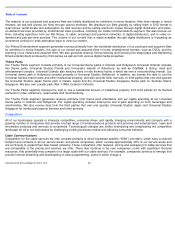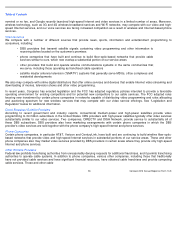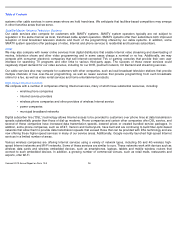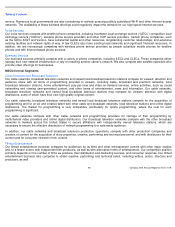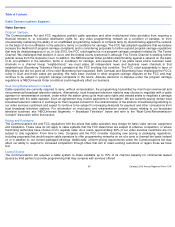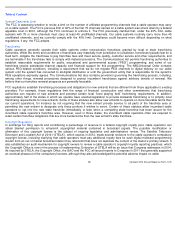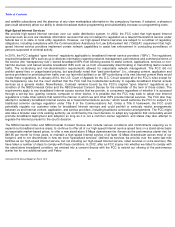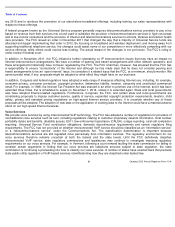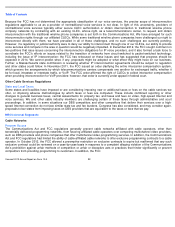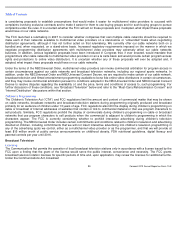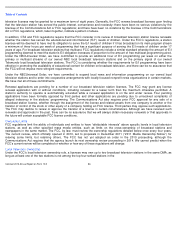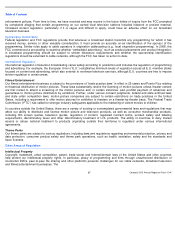Comcast 2013 Annual Report Download - page 26
Download and view the complete annual report
Please find page 26 of the 2013 Comcast annual report below. You can navigate through the pages in the report by either clicking on the pages listed below, or by using the keyword search tool below to find specific information within the annual report.
Table of Contents
ary 2015 and to reinforce the promotion of our stand-
alone broadband offerings, including training our sales representatives with
respect to these offerings.
A federal program known as the Universal Service program generally requires telecommunications service providers to pay a fee
based on revenue from their services into a fund used to subsidize the provision of telecommunications services in high-
cost areas
and to low-
income consumers and the provision of Internet and telecommunications services to schools, libraries and certain health
care providers. The FCC issued an order in November 2011 that changed the way that a majority of Universal Service funds are
allocated and began implementing that order in 2012. By focusing on broadband and wireless deployment, and moving away from
supporting traditional telephone service, the changes could assist some of our competitors in more effectively competing with our
service offerings, while others could receive less funding. The actual impact of the changes is not yet known. The FCC’
s ruling is
under review in federal court.
In addition, in November 2011, the FCC initiated a further rulemaking on IP interconnection issues that may have an impact on
Internet interconnection arrangements. We have a number of peering and transit arrangements with other network operators, and
these arrangements historically have not been regulated by the FCC. The FCC Chairman, however, has stressed that the FCC has
a responsibility to ensure “connectivity”
of the Internet and although he has made clear that he does not consider peering and
transit arrangements to be an “open Internet”
issue, he considers it a related issue that the FCC, at a minimum, should monitor. We
cannot predict what, if any, proposals might be adopted or what effect they might have on our business.
In addition, Congress and federal regulators have adopted a wide range of measures affecting Internet use, including, for example,
consumer privacy, consumer protection, copyright protection, defamation liability, taxation, obscenity and unsolicited commercial
email. For example, in 1998, the Internet Tax Freedom Act was enacted in an effort to promote use of the Internet, and it has been
extended three times, but is scheduled to expire on November 1, 2014, unless it is extended again. State and local governments
also have adopted Internet-
related regulations. Furthermore, Congress, the FCC, and certain state and local governments are
considering proposals to impose customer service, quality of service, expanded copyright protection requirements, taxation, child
safety, privacy and standard pricing regulations on high-
speed Internet service providers. It is uncertain whether any of these
proposals will be adopted. The adoption of new laws or the application of existing laws to the Internet could have a material adverse
effect on our high-speed Internet business.
Voice Services
We provide voice services by using interconnected VoIP technology. The FCC has adopted a number of regulations for providers of
nontraditional voice services such as ours, including regulations relating to customer proprietary network information, local number
portability duties and benefits, disability access, E911, law enforcement assistance (CALEA), outage reporting, rural call completion
reporting, Universal Service Fund contribution obligations, domestic discontinuance requirements and certain regulatory filing
requirements. The FCC has not yet ruled on whether interconnected VoIP service should be classified as an “information service”
or a “telecommunications service”
under the Communications Act. The classification determination is important because
telecommunications services are still regulated more pervasively than information services. The regulatory environment for our
voice services therefore remains uncertain at both the federal and the state levels. Until the FCC definitively classifies
interconnected VoIP service, state regulatory commissions and legislatures may continue to investigate imposing regulatory
requirements on our voice services. For example, in Vermont, following a court remand faulting the state commission for failing to
consider certain arguments in finding that our voice services are telephone services subject to state regulation, the state
commission is continuing a proceeding into how to classify our voice services. A number of states have enacted laws that preclude
state public utility regulation of VoIP-based services notwithstanding how they are classified under federal law.
21
Comcast 2013 Annual Report on Form 10
-
K



